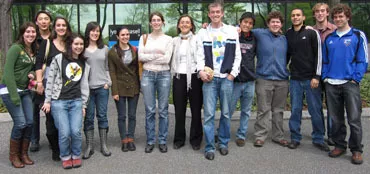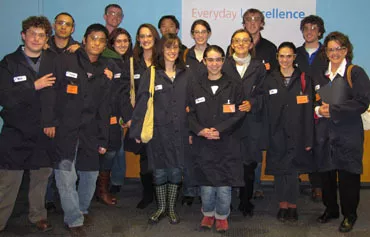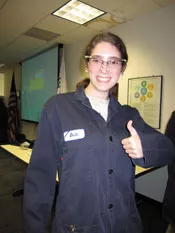Visit to LyondellBasell Labs

While other chemistry classes spent their last lab of the year identifying chemical unknowns or crunching enzyme data, those of us in the Inorganic Chemistry course (and a few Chemistry majors and minors) took a break from synthesizing quantum dots and went on a field trip to LyondellBasell Industries in Newtown Square, PA. The third largest chemical manufacturer in the world, LyondellBasell is a global leader in petrochemical and polymer technology and production. The trip was arranged by our professor, Dr. Liliya Yatsunyk, as a chance for us to tour a major R&D facility and learn about career opportunities in industry.

In the executive meeting room, LyondellBasell employees educated us about their research on heterogeneous and homogenous catalysis (the former describes a system in which the catalyst and reactants are in different phases; the latter, the same phase). Inorganic Chemistry is generally the last lecture course taken in the core curriculum, so most of us had learned about both forms of catalysis in various contexts; seeing them applied in real-world industry was a nice capstone to the curriculum. The employees also held a Q&A section in which they answered, quite candidly, our questions ranging from how much they actually enjoy their jobs (a lot) to how much money matters in industrial research (a lot).

The main attraction was a tour of the lab facilities, which struck Laura Wang '10 as particularly edifying. "It was interesting to see the analytical section," she remarked, "because I recognized a lot of the instruments from Chem 43 with Alison [Holliday]." The analytical division boasted a beautiful, modern ICP-AES (inductively coupled plasma atomic emission spectroscopy) instrument, which is used to detect the concentration of trace metal elements in samples. The NMR specialist showed us her stack of mail-order NMR analyses. Industrial employees, she explained, have the privilege of sending in their samples to a professional analysis company, which will identify chemical shifts and elucidate probable structures for them. Those of us going to grad school or who have used NMR for undergraduate research are not so fortunate. My personal favorite piece of equipment was the x-ray crystallography sample grinder, an appallingly heavy metal chamber that smashes solid samples into fine dust within a matter of seconds-in physical chemistry, we labored at our samples with an old-fashioned mortar and pestle.
The experience was a lot of fun and educational. Ariel Horowitz '10 said, "Our visit was very informative, gave a great idea of their corporate culture, and everyone was very nice."



